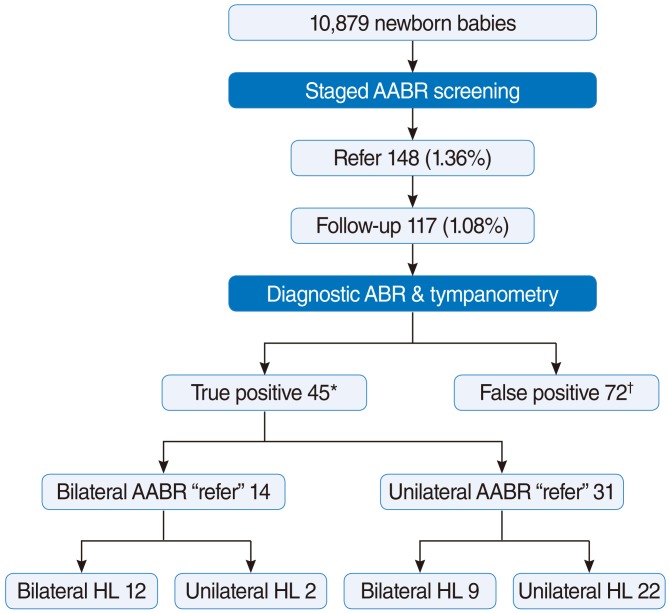1. American Academy of Pediatrics. Joint Committee on Infant Hearing. Year 2007 position statement: principles and guidelines for early hearing detection and intervention programs. Pediatrics. 2007; 10. 120(4):898–921. PMID:
17908777.
2. Joint Committee on Infant Hearing. American Academy of Audiology. American Academy of Pediatrics. American Speech-Language-Hearing Association. Directors of Speech and Hearing Programs in State Health and Welfare Agencies. Year 2000 position statement: principles and guidelines for early hearing detection and intervention programs. Joint Committee on Infant Hearing, American Academy of Audiology, American Academy of Pediatrics, American Speech-Language-Hearing Association, and Directors of Speech and Hearing Programs in State Health and Welfare Agencies. Pediatrics. 2000; 10. 106(4):798–817. PMID:
11015525.
3. Korres S, Nikolopoulos TP, Peraki EE, Tsiakou M, Karakitsou M, Apostolopoulos N, et al. Outcomes and efficacy of newborn hearing screening: strengths and weaknesses (success or failure?). Laryngoscope. 2008; 7. 118(7):1253–1256. PMID:
18401271.

4. Iwasaki S, Hayashi Y, Seki A, Nagura M, Hashimoto Y, Oshima G, et al. A model of two-stage newborn hearing screening with automated auditory brainstem response. Int J Pediatr Otorhinolaryngol. 2003; 10. 67(10):1099–1104. PMID:
14550964.

5. Benito-Orejas JI, Ramirez B, Morais D, Almaraz A, Fernandez-Calvo JL. Comparison of two-step transient evoked otoacoustic emissions (TEOAE) and automated auditory brainstem response (AABR) for universal newborn hearing screening programs. Int J Pediatr Otorhinolaryngol. 2008; 8. 72(8):1193–1201. PMID:
18550180.

6. Lin HC, Shu MT, Lee KS, Ho GM, Fu TY, Bruna S, et al. Comparison of hearing screening programs between one step with transient evoked otoacoustic emissions (TEOAE) and two steps with TEOAE and automated auditory brainstem response. Laryngoscope. 2005; 11. 115(11):1957–1962. PMID:
16319605.

7. Vohr BR, Oh W, Stewart EJ, Bentkover JD, Gabbard S, Lemons J, et al. Comparison of costs and referral rates of 3 universal newborn hearing screening protocols. J Pediatr. 2001; 8. 139(2):238–244. PMID:
11487750.

8. Johnson JL, White KR, Widen JE, Gravel JS, James M, Kennalley T, et al. A multicenter evaluation of how many infants with permanent hearing loss pass a two-stage otoacoustic emissions/automated auditory brainstem response newborn hearing screening protocol. Pediatrics. 2005; 9. 116(3):663–672. PMID:
16140706.

9. Wada T, Kubo T, Aiba T, Yamane H. Further examination of infants referred from newborn hearing screening. Acta Otolaryngol Suppl. 2004; 10. (554):17–25. PMID:
15513505.

10. Adachi N, Ito K, Sakata H, Yamasoba T. Etiology and one-year follow-up results of hearing loss identified by screening of newborn hearing in Japan. Otolaryngol Head Neck Surg. 2010; 7. 143(1):97–100. PMID:
20620626.

11. Holster IL, Hoeve LJ, Wieringa MH, Willis-Lorrier RM, de Gier HH. Evaluation of hearing loss after failed neonatal hearing screening. J Pediatr. 2009; 11. 155(5):646–650. PMID:
19616786.

12. Shoup AG, Owen KE, Jackson G, Laptook A. The Parkland Memorial Hospital experience in ensuring compliance with universal newborn hearing screening follow-up. J Pediatr. 2005; 1. 146(1):66–72. PMID:
15644825.

13. Casselbrant ML, Brostoff LM, Cantekin EI, Flaherty MR, Doyle WJ, Bluestone CD, et al. Otitis media with effusion in preschool children. Laryngoscope. 1985; 4. 95(4):428–436. PMID:
4039020.

14. Talero-Gutierrez C, Carvajalino-Monje I, Samper BS, Ibanez-Pinilla M. Delayed auditory pathway maturation in the differential diagnosis of hypoacusis in young children. Int J Pediatr Otorhinolaryngol. 2008; 4. 72(4):519–527. PMID:
18243343.
15. Ho V, Daly KA, Hunter LL, Davey C. Otoacoustic emissions and tympanometry screening among 0-5 year olds. Laryngoscope. 2002; 3. 112(3):513–519. PMID:
12148864.

16. Engel J, Anteunis L, Chenault M, Marres E. Otoscopic findings in relation to tympanometry during infancy. Eur Arch Otorhinolaryngol. 2000; 7. 257(7):366–371. PMID:
11052246.

17. Paradise JL, Smith CG, Bluestone CD. Tympanometric detection of middle ear effusion in infants and young children. Pediatrics. 1976; 8. 58(2):198–210. PMID:
951134.

18. Shahnaz N, Miranda T, Polka L. Multifrequency tympanometry in neonatal intensive care unit and well babies. J Am Acad Audiol. 2008; 5. 19(5):392–418. PMID:
19253812.

19. Keefe DH, Gorga MP, Neely ST, Zhao F, Vohr BR. Ear-canal acoustic admittance and reflectance measurements in human neonates: II. predictions of middle-ear in dysfunction and sensorineural hearing loss. J Acoust Soc Am. 2003; 1. 113(1):407–422. PMID:
12558278.
20. Fitzpatrick EM, Durieux-Smith A, Whittingham J. Clinical practice for children with mild bilateral and unilateral hearing loss. Ear Hear. 2010; 6. 31(3):392–400. PMID:
20054278.

21. Tharpe AM. Unilateral and mild bilateral hearing loss in children: past and current perspectives. Trends Amplif. 2008; 3. 12(1):7–15. PMID:
18270174.






 PDF
PDF Citation
Citation Print
Print




 XML Download
XML Download